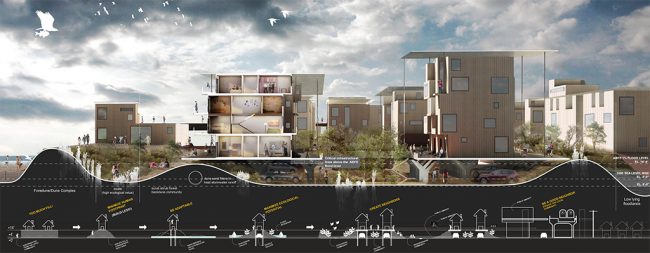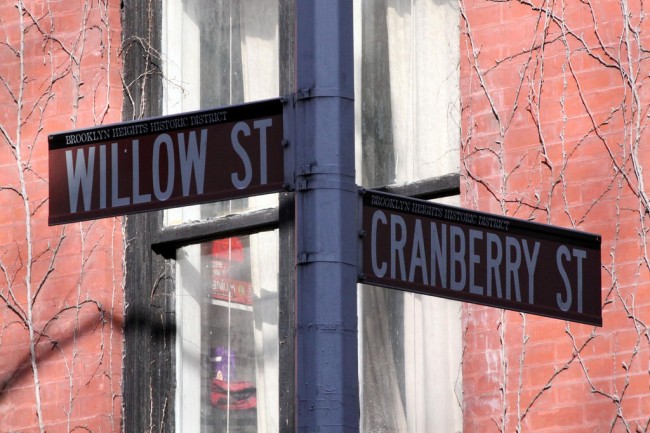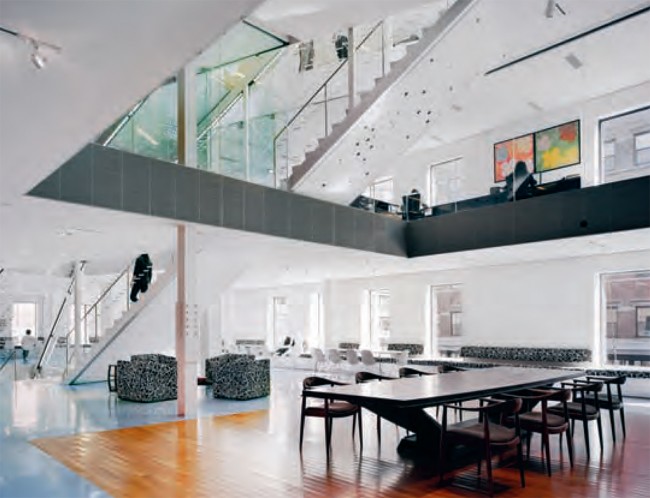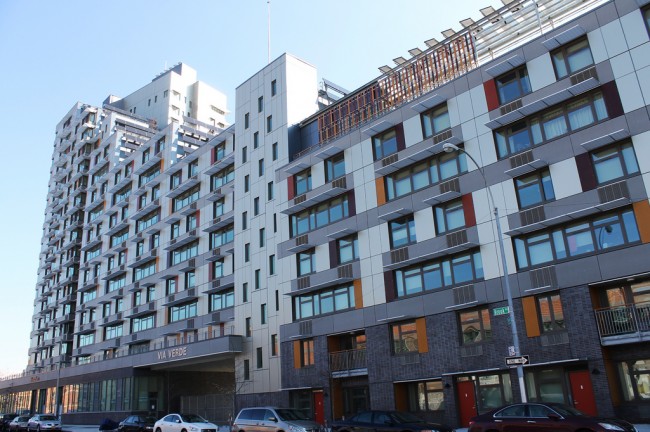
We are celebrating 15 years — and counting — of stories that are deeply researched and deeply felt, that build a historical record of what the city has been.
We are celebrating 15 years — and counting — of stories that are deeply researched and deeply felt, that build a historical record of what the city has been.

F.R.E.D. by Ennead Architects, one of four finalists in the FAR ROC design ideas competition | Photo via FAR ROC
FAR ROC FINALISTS
The finalists for phase one of FAR ROC, a design ideas competition, were announced yesterday. In the wake of Sandy, the competition aims to explore innovative yet affordable best practices and strategies for the development of Arverne East, a low-lying 80+ acre site in the Rockaways. The four finalists — Ennead Architects, Lateral Office, Seeding Office, and White Arkitekter — each will be given a $30,000 stipend to further develop their proposals for the next phase of the competition. The winning project will be used to inform ongoing planning work at Arverne East and in other densely populated seaside areas.
LIQUID CITY
“This is a city built not just near the water, but over, under, and in it.” So says Justin Davidson in “Liquid City,” his recent New York Magazine feature on New York City’s tumultuous relationship with its surrounding waters. Prompted by the June release of the City’s post-Sandy plan, “A Stronger, More Resilient New York,” Davidson recounts the history of trade, industry, leisure, and residence along the shores through periods of growth and decline — “a long and crazy romance, fueled by manic energy, gilded dreams, violence, abandonment, and elated rediscovery.”

Street Signs in Brooklyn Heights | Photo via Matt Karp
FRUIT STREETS
Untapped Cities took a trip to check out the fruit streets of Brooklyn Heights. In the most commonly agreed upon origin story, 19th century resident Lady Middagh found the previous street names, which were based on aristocratic families, pretentious and went on a personal crusade to replace them, successfully planting Cranberry, Pineapple, and Orange Streets.
THE END OF THE G TRAIN SPRINT
The only subway line that doesn’t pass through Manhattan, the G train has always made its riders work just a little harder. Because of its four-car length — which makes the trains much shorter than the platforms they stop on — both regulars and first-timers are forced to chase the train depending on where it stops on the platform. The MTA has committed to implement several improvements to end the so-called “G Train Sprint”: installing designated stopping points along the platform, adding more instructional waiting signs, and moving benches closer to the train’s actual stopping point.
A $150,000 TREE
The Bloomberg administration’s initiative to plant one million new trees across the five boroughs over the course of a decade has received plenty of attention since its 2007 launch, but many New Yorkers may be unaware of the measures that have been put in place to keep healthy trees in the ground once they get there. Because of a 2010 law, homeowners and builders who remove healthy trees from public sidewalks must pay the City a fee determined by a “trunk-formula method” that takes into account the size, health, and location of the tree, or in some cases pay for replacement trees to be planted in nearby locations. As one Staten Island builder learned, the fee for established large trees can add up to hundreds of thousands of dollars.
I LOVE MY HOOD
In order to preserve and amplify the character of Washington Heights in the face of increasing gentrification, street artist Dister Rondon started “I Love My Hood.” A Heights native, he spray paints murals depicting the daily life of local residents, tagged with “I Love My Hood.” Rondon explains, “It’s not about moving out of your hood and ‘making it.’ How about you stay in your hood and make it better?”

Office design that encourages active use | Courtesy of The Center For Active Design
A BUILT LEGACY
As Mayor Bloomberg’s three-term tenure comes to an end, WNYC is looking back at “the outsized mark Mayor Michael Bloomberg has had on our physical landscape and the increasingly vertical city in which we all live.” Zoning changes and Liberty Bonds were key factors pushing buildings taller, but real estate developers cite Bloomberg’s encouragements and assorted other city policies as equally significant reasons they chose to pursue greater heights. Adding a new tool to his aggressive public health efforts, the mayor is also encouraging New Yorkers to take the stairs. Two proposed bills will require city agencies to increase visibility and access of stairways and apply smart “active design” strategies to building construction.
FINDING QUIET IN THE CITY
With the mélange of jackhammering, honking, and yelling emanating from urban streets, silence is a rare find in the five boroughs. Fortunately, The New York Times has put together an interactive map displaying tried and true escapes from the city’s constant din collected from readers.

Via Verde, a green affordable housing development in the Bronx whose property manager will be present at Keeping It Green | Photo via Jules Antonio
EVENTS AND STUFF TO DO
MASTERPIECES OF EVERYDAY NEW YORK: OBJECTS AS STORY
Currently up at Parsons The New School for Design’s Sheila C. Johnson Design Center is an exhibition featuring 62 objects that “narrate a biography of this place,” New York City. Selected by faculty members from all disciplines, these items exemplify and embody life in the city, from the mundane routines to the exuberant moments.
KEEPING IT GREEN
Despite advances in the field of green building design, the operational practices of staff and residents can undermine the true efficacy of sustainability measures. Next Thursday, the Urban Green Council will host Keeping It Green: Operating Affordable Housing, a panel to discuss this common challenge in affordable housing featuring property managers from several new green housing developments.
TOMATO FIGHT!
Get ready for the ultimate food fight tomorrow as the Tomato Battle makes its New York debut at Floyd Bennett Field. 40,000 pounds of tomatoes will be at your disposal, so practice your aim, and sign up today.
The Roundup keeps you up to date with topics we’ve featured and other things we think are worth knowing about.
The views expressed here are those of the authors only and do not reflect the position of The Architectural League of New York.